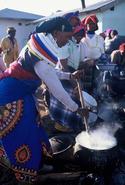Dwellings at Kwarrielaagte

The dwellings at Kwarrielaagte reflect the overall sense of community and solidarity among the Ntwana. Their homesteads are microcosms of the larger community and represent the private world of the family within the broader society.
Access from the communal courtyard (kgoro) to the homesteads is via public passageways, radiating at every two or three alternate homesteads. Ntwana women are entitled to their own homesteads after the birth of their first child. In cases where a man has more than one wife (the Ntwana are polygynous), two or three more homesteads are built adjacent to one another.
Ntwana women decorate the outer and inner main walls of the courtyards framing the homestead. Packed and plastered by the women, the walls are comprised of earth, dung and coarse aggregate stone.
They are decorated at the end of the harvest, at the beginning of the dry season and during the period between the harvesting of the crops and the sowing of the next year's produce. Mural decoration is one of the first tasks undertaken by a new bride, but it is not necessarily a solitary task as female relatives often lend a hand.
Red, white and black coloured soil is combined (limo), which is used both to decorate the walls and serve as a protection against witchcraft. Once these pigments have been combined, the women paint the walls with it using either their fingers or sticks. Unlike colourful Ndebele murals with their spectacular designs, Ntwana mural decoration is sparse, minimalist and monochromatic, consisting of delicate geometric patterns or criss-cross motifs.
While the object is to beautify the homestead, the soil types are also believed to be imbued with medicinal, protective or healing functions. The same colour triad (red, white and blue/black) recurs in all aspects of Ntwana material culture, and various elements which are either associated conceptually or visually with the colour triad are used extensively in both rituals and everyday situations.
However, the triad pervades beyond the context of rites of passage and formal social rituals. It appears on Ntwana female apparel, in the beadwork of the frontal and rear aprons, and on the rosettes worn on the side of Ntwana women's heads. Furthermore, its soil constituents are used on Ntwana homestead walls as a magical, religious means of protection against both natural and mystical causes of misfortune.